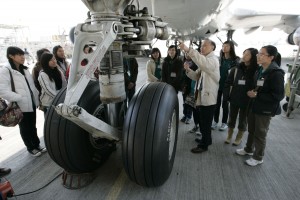By Nicholas Kralev
The Washington Times
March 9, 2009
It’s no secret that times are rough for the airline industry, and the glamor once associated with it is long gone. Many children, however, still dream of a life in the sky. Should they be encouraged?
The answer of Cathay Pacific Airways, Hong Kong’s main airline, is a resounding yes. In 2003, it started a program for high school students called “I Can Fly,” which teaches young aviation enthusiasts the basics of the industry at no cost — from piloting and engineering to marketing and customer service.
About 3,000 students have graduated from the three programs in Hong Kong so far, said Elsa Leung, Cathay’s corporate communication manager. Pilots, flight attendants and other airline and airport staff share their knowledge and experience during lectures, field trips and hands-on exercises.
So if you — or your child — ever wanted to take a behind-the-scenes look at the cockpit, the air-control tower or parts of the airport that are off limits for the public, this might be your chance.
“The program is not just about career — it’s more about building up the youth in their personality and mentality,” Ms. Leung said. “Youth is a very important resource of the community who deserves more opportunities and guidance. We believe it’s good and necessary for us to offer these young people more chances to know more about aviation.”
This year, Cathay has organized its first “I Can Fly” program in the United States. It started last month in the San Francisco Bay Area and runs for nine weeks, with evening classes once a week.
“All of us remember our youth when we knew exactly what we wanted to do when we grew up,” said Gus Whitcomb, Cathay’s communications manager for the Americas. “This program allows young people to explore that career in advance and decide if it’s really what they want to do before they have to commit.”
The program is also rewarding for the airline’s staff, most of whom volunteer their time.
“Seeing the aviation industry again through the eyes of wonderment and fascination makes you doubly happy to be doing what you’re doing,” Mr. Whitcomb said. “I have done programs like this with other airlines, and I still have the kids — now young adults with kids of their own — e-mailing me about their promotion to captain or asking advice on a possible job change at their airline.”
Cathay employees, referred to as “leaders” during the program, usually send messages to participants after graduation.
“Learning to fly is a challenging and intensive experience,” wrote Michael Jardin, one of the pilot leaders. “There will be those that question your decision. But I can also promise you that, if you have the passion and will to see it through, it will be one of the most rewarding and satisfying experiences of your life.”
The application requirements for “I Can Fly” are simple: a grade point average of at least 2.0 and demonstrated interest in aviation or community service. That’s right — the program is as much about community service as it is about the airline industry, and participants’ performance is judged by their abilities in both areas.
“We want to let them learn about contribution to the society,” Ms. Leung said. “We hope the members, under the leadership of our pilots and staff, understand how to care for people in need. And that’s why one of activities in the program is that they have to organize social services on their own.”
Community service and charity are no strangers to the airline industry — both its employees and customers. Just last week, representatives of United Airlines paid a visit to children undergoing cancer treatment at Georgetown University Hospital in Washington to deliver teddy bears.
United, which partnered with the American Cancer Society for this project, had previously surprised young patients in Denver and Chicago. Last year, the airline asked its customers to donate frequent-flier miles or money to the organization so that children who need to travel for treatment could be flown to the respective hospitals.
“Nonprofits feel the economic punch as much as anyone, but our customers have found a way to continue contributing to a cause that’s important to them,” said United spokesman Jeff Kovick. “This year’s two-month initiative raised 55 million miles from our customers — last year’s was 45 million — in addition to $160,000.”
This column was first published by The Washington Times

